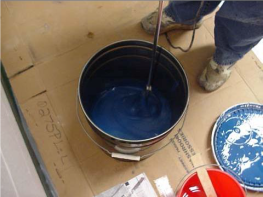Epoxy.com Product #633 Novolac Epoxy Coating is installed basically in 3 Steps.
- Properly prepare the substrate

- Apply 1 coat of Epoxy.com Product #899 Primer at a rate of 250 to 300 SF per gallon per coat.
- Apply 2 coats of Epoxy.com Product #633 at a rate of 160 to 200 SF per gallon per coat.
Product #899 Epoxy Primer and Product #633 Coating are mixed and applied the same way. These are the only differences:
- The spread rate
- The optional anti-skid is typically only added to the #633
For the sake of simplicity the procedure for mixing and installing is mentioned once below because the three coats apply virtually the same way.
Before You Start
Before you start you will want to read the following.
- Do with Epoxies – The things that you don’t want to forget to do when using epoxy.
- Don’ts with Epoxies – Don’t do any of these things when using epoxy.
- Surface Preparation – Surface preparation sets the foundation for your application. If you want your job to work better and last longer be sure to read and follow these steps.
- For a list of job supplies to install a chip flooring see www.epoxy.com/job-supplies.aspx
- Be sure to mix both the A and the B sides of your material before starting. Be sure to use a clean stir stick or mixing paddle for both. Do not cross contaminate.
Optional Cove
Cove Base Installation – Epoxy Cove installation used to be very difficult to install. With Epoxy.com Products and this installation guide, this job is made much easier.
Primer
When installing over concrete or wood you will first want to prime with Product #899 Epoxy Primer –www.epoxy.com/899.aspx. The purpose of this primer is to go on thin (250-300 square feet per gallon) and seal the floor so you do not get air or moisture coming up into your epoxy coating which will be going on thick (160-200 square feet per gallon). The 899 epoxy primer is also thinner than the coating and so it flows out better. Over stainless steel, aluminum and galvanized metal use Epoxy.com Product #660 Aluminum Filled for the primer.
MIXING INSTRUCTIONS
Mixing is by far the most important part of installation. One method to insure accurate mix ratios is to put measurements on sticks with the appropriate mix ratio. In the case of the 899 and 633 this is 2 Parts A to 1 Part B, so you might do 3 inches “A” to 1.5 inch of “B”
mix ratios is to put measurements on sticks with the appropriate mix ratio. In the case of the 899 and 633 this is 2 Parts A to 1 Part B, so you might do 3 inches “A” to 1.5 inch of “B”
It is sometimes helpful to put some duct tape on the A stick. It will help you to see your line when using the pigmented “A” side
Be sure to properly protect the floor where you will be doing your mixing.
Stir the Resin “A” and the Hardener “B ”each separately in their original container before measuring and mixing the two together. Be careful to use separate stir sticks so not to cross contaminate.
Temperature of Epoxy.com Product #899 Primer and Epoxy.com Products #1, #2 and #633 must be 50 degrees F or above at time of mixing. Stir each component separately before blending. Mix two parts by volume of Part A with one part by volume of Part B for three minutes with a low speed electric drill motor equipped with a mixing paddle. Be sure the mixing paddle is large enough to mix the material completely. You will want to use a “propeller” type mixer with blades 5 inches or bigger.
Preparing to Mix Resin and Hardener Together
- A 5 gallon metal pail or 5 gallon plastic pail makes a great mixing
 bucket.
bucket. - Always be sure that your mix bucket is clean and is not contaminated with anything before you mix.
- Some people like to use the two bucket method. That allows your person mixing to be mixing while your install people are installing the last bucket.
- If you start to show signs of your material hardening in the mix bucket, start using a new one.
Mixing Tools
- Typically you will want to use a paddle mixer, that goes into a low speed drill.
- Your drill mixer should be large enough to stir the entire batch at once. A mixer that only moves only the partial contents of the pail, may result in inadequate mixing. Be sure that you use a clean mixing paddle. A dirty mixing paddle can result in poor mixing or contamination of the batch.
- When mixing try not to whip any unnecessary air into your mix, by using the slowest drill speed and keeping the mixing paddle reasonably level.
Mixing
- Carefully measure out the “A” resin and the “B” hardener into two other containers.
- Pour “A” resin into your mixing bucket and then pour the “B” hardener into the mixing bucket. Always pour the “A” first and then the “B”
- Stir for 3 minutes, being sure to scrape the bottom and sides as you mix.

If Anti-Skid Course or Anti-Skid Fine is to be used add 12-16 volume ounces per mixed gallon, and mix until properly dispersed, typically 1-2 minutes.
Doing the Trim
• Trim around all the areas that are difficult to roll.
• Remember not to get two far ahead, you don’t want the material to set up before it is  broadcast.
broadcast.
• Also remember to pull the duct tape while the material is still wet
APPLICATION
Epoxy.com Product #899 can be applied with a brush, roller or squeegee at a rate of 250-300 square feet per gallon. Remember that if you put it on too thick you can get bubbles in the 899 Epoxy Primer. The important thing is to  completely wet out the concrete without leaving excessive material. Allow the 899 primer to cure until hard. Typically, 10-12 hours at 75 degrees F. Do not allow more than 24 hours between this coat and the coat of coating to follow it. Epoxy.com 899 Primer typically requires only 1 coat.
completely wet out the concrete without leaving excessive material. Allow the 899 primer to cure until hard. Typically, 10-12 hours at 75 degrees F. Do not allow more than 24 hours between this coat and the coat of coating to follow it. Epoxy.com 899 Primer typically requires only 1 coat.
The Epoxy.com Product #633 Novolac Epoxy Coating is typically applied at a rate of 160-200 SF per gallon per coat. Typically, 2 coats of Epoxy.com Product #633 High Chemical Resistance Epoxy are required. These coatings can be applied with the same tools as #899 Epoxy Prime.
When Product #633 is applied over concrete or wood, prime with Product #899 Epoxy Primer and allow the Product #899 Primer to cure to tack free. Over stainless steel, aluminum and galvanized metal use Epoxy.com Product #660 Aluminum Filled for the primer. Be sure to install the 633 within 24 hours of the installation of the primer.
For typical installations as a coating apply 2 coats of Product #633 Novolac Epoxy at a rate of 160-200 square feet per gallon per coat. This yields a wet film thickness of 8-10 mils thick per coat or 16 – 20 mils for the two coats. Since this is a 100% solids Resin and Hardener system, there is no loss during drying, so the wet film thickness and the dry film thickness for 2 coats will be identical (16-20 mils DFT). Be sure to install the second coat after the 1st coat is hard enough to walk on but before 24 hours after the installation of the previous coating.
If Anti-Skid Fine or Anti-Skid Course epoxy anti-skid additive is used add plus or minus 12 volume ounces of Anti-Skid per mixed gallon of Product #633. Never add more than 16 volume ounces per gallon of Resin and Hardener mix.
In summary:
Step 1. Good Surface Preparation
Step 2. Apply 1 coat of Epoxy.com Product #899, at a rate of 250-300 SF per gallon
Step 3. Apply 2 coats of the appropriate Product #633 Highly Chemical Resistant Novolac Epoxy Coating. Add optional anti-skid if required.
For additional help please contact Epoxy.com Technical Support at 352-533-2167 or email norm@epoxy.com.
Additional Resources:

[…] Product #633 Novolac Epoxy Chemical Resistant Epoxy Coating is a 100% solids epoxy Novolac coating ideal for harsh chemical and solvent resistant applications. Product #633 Novolac Epoxy Chemical Resistant Epoxy Coating is used in secondary containment, solvent storage, pump pads, trenches, and other high exposure areas. This Installation Guide will help you install Product #633 Novolac Epoxy Chemical Resistant Epoxy Coating. You can also find more information with pictures about installation on this page the Epoxy.com Blog. […]